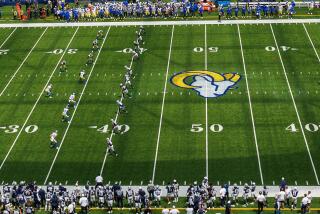When Heads Knock, Helmet Listens
- Share via
NORMAN, Okla. — The popularity of amateur athletics has exploded in recent years, accompanied by a sophisticated era in sports medicine. Surprisingly little is known, however, about a common malady: the concussion. Several colleges are trying to change that.
Armed with high-tech football helmets that offer detailed data about blows to the head, they are hoping to render obsolete a quaint but exasperating question: How many fingers am I holding up?
At the University of Oklahoma -- whose team will battle USC in the Orange Bowl on Jan. 4 for the college football championship -- 10 helmets were equipped this season with the Head Impact Telemetry System, or HITS.
Oklahoma trainer Scott Anderson and his staff removed a piece of padding from each helmet, which is not for protection but mostly to cut down on crowd noise, and replaced it with a halo-shaped device.
The unit is equipped with six accelerometers, sensors similar to those used to trigger automobile air bags. When a player is struck in the head, the sensors record the direction the hit came from and the severity and duration of the blow.
The data are transmitted wirelessly to a computer on the sidelines. If a player receives a blow over a threshold that is considered dangerous, the system automatically pages doctors and trainers, telling them which player received the hit and the severity of the impact.
The laptop produces real-time graphics tracking the blows received by every player throughout a game. The system is tough enough to measure the hardest hits in football -- which can surpass 150 Gs, roughly the force of a serious car accident -- but sensitive enough to distinguish between a tackle and a player head-butting a teammate in celebration.
The result is the first precise measurement of head impacts on the field, a development that is expected to yield a clearer picture of the biomechanics of concussions, said David W. Bertoni, a vice president at Simbex, the company in Lebanon, N.H., that developed the system. Simbex officials hope the device will evolve to the point that teams will develop a “suspect impact profile” for every player -- a formula used to predict when he is in danger of suffering a concussion.
Last year, Virginia Tech used eight helmets in a pilot program, recording about 3,000 impacts over the course of the season. This year, 45 helmets were in rotation at Virginia Tech, the University of Oklahoma and the University of North Carolina. About 20,000 impacts have been recorded this season.
Whether use of the technology becomes widespread may depend largely on price considerations: OU’s helmets cost about $30,000 for the season, said team physician Brock Schnebel, “and we got a break on them.”
Riddell Sports Group of Chicago, the nation’s largest supplier of protective football equipment, recently purchased the technology from Simbex. A Riddell spokesman said the company would like to have 1,000 helmets in rotation next season.
The technology still needs some work. At OU’s Memorial Stadium, for instance, there are so many cellphone towers in the area that the signals between the helmets and the computer on the sidelines often are interrupted, Schnebel said.
But Schnebel and Anderson have been able to draw some conclusions from their initial testing. They found that offensive linemen, for example, were struck in the head more often than downfield players like wide receivers, but the blows to linemen’s heads were less severe because they didn’t get up as much steam before striking their opponent.
Schnebel allowed players in a high school football program to wear some of the helmets. To his surprise, the high school players received many hits that were nearly as vicious as those recorded among college players.
And many high school players, unlike their college counterparts, also go “both ways” -- they play both offense and defense. So high school athletes may be involved in more plays over the course of a game, making them more susceptible to potential head injuries.
For those who have dedicated their careers to making football safer, the early reports are tantalizing; the technology, they say, could have a broad effect. Football players could be taught to change their tackling techniques. Or there could be new helmet designs and rule changes restricting blows to the head.
In soccer, the research could help settle a long-simmering debate about whether it is damaging for young players to strike the ball with their heads. New helmets could be developed for other sports, such as ice hockey and downhill skiing.
“There are so many paths where this could lead,” said Thad Ide, Riddell’s vice president of research and development. “We are just starting to scratch the surface.”
More to Read
Go beyond the scoreboard
Get the latest on L.A.'s teams in the daily Sports Report newsletter.
You may occasionally receive promotional content from the Los Angeles Times.











